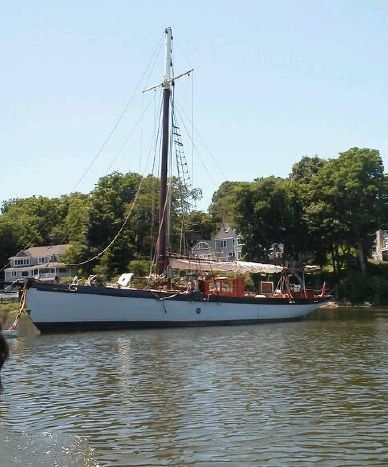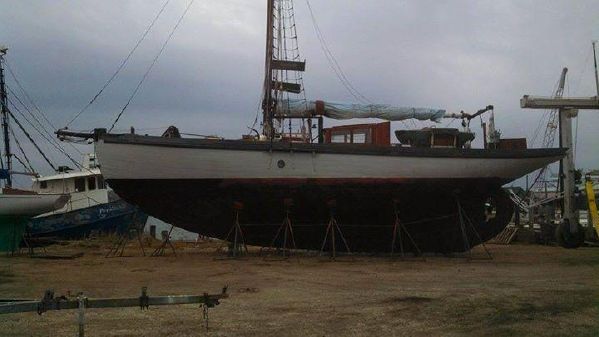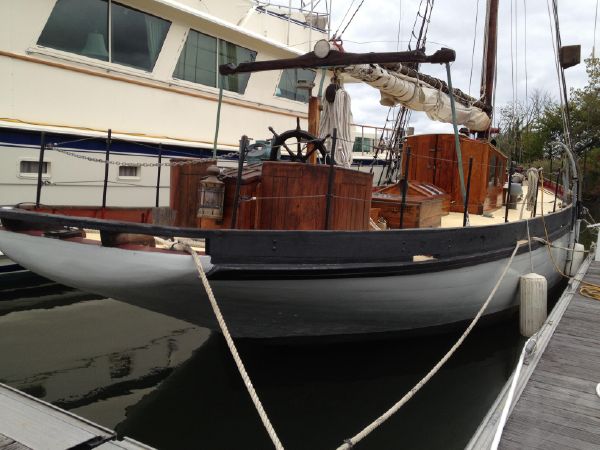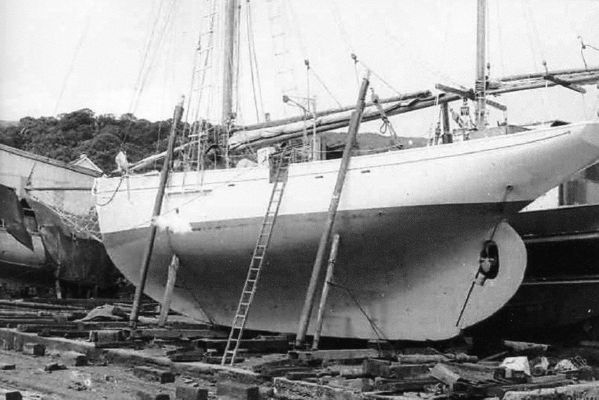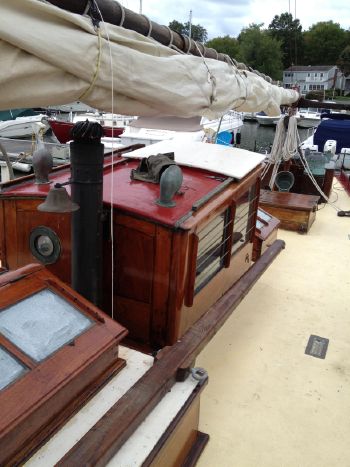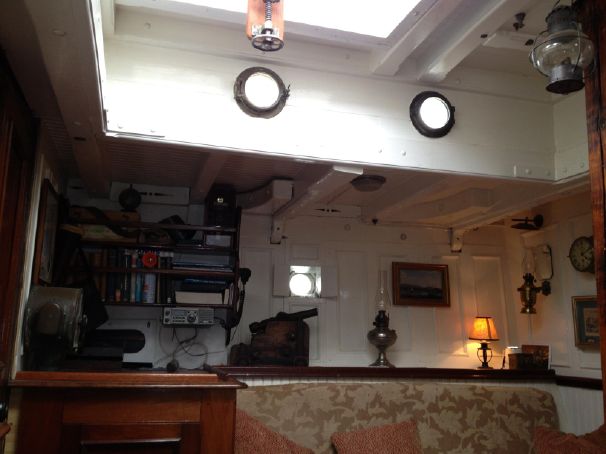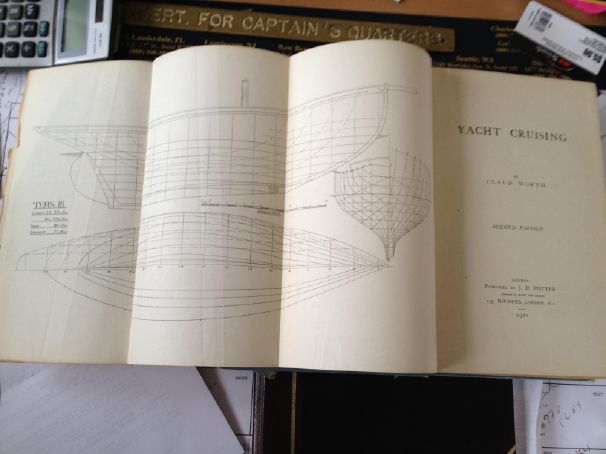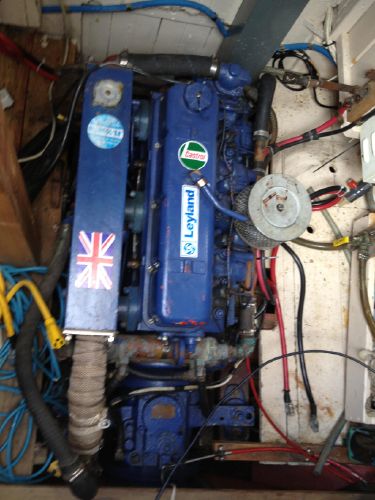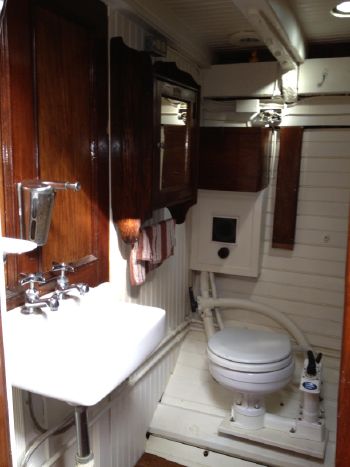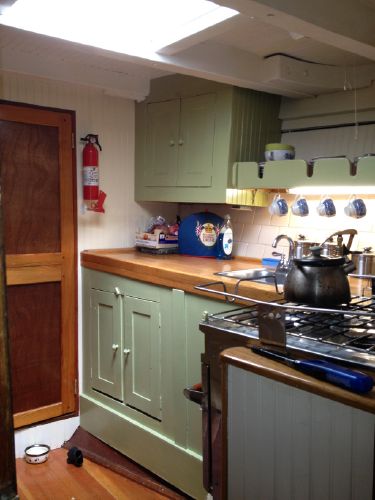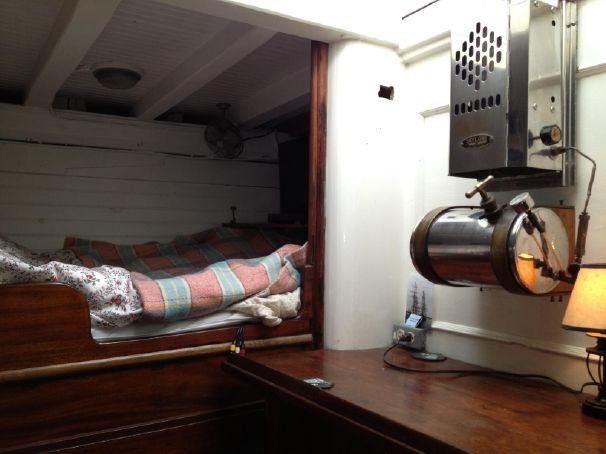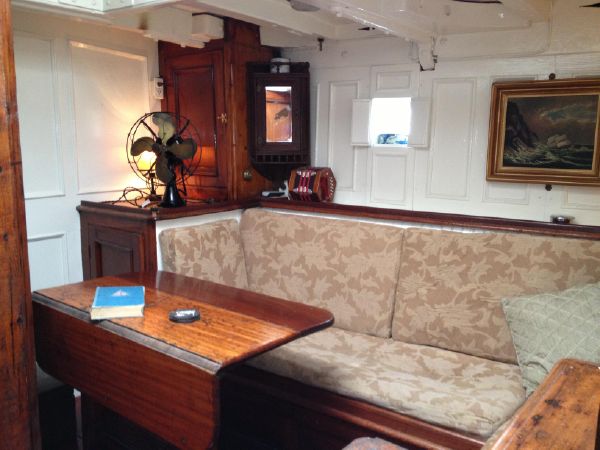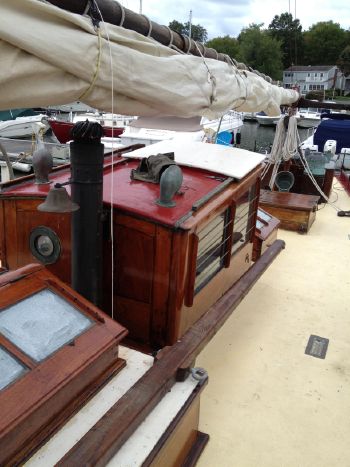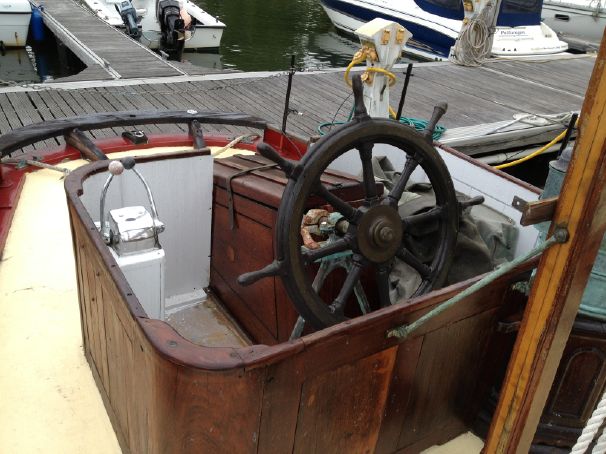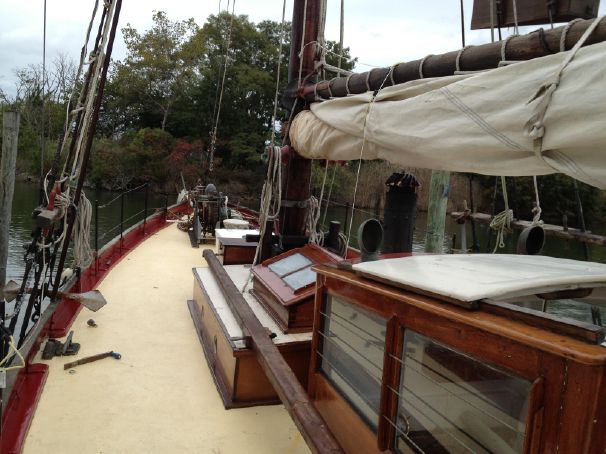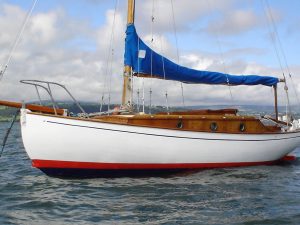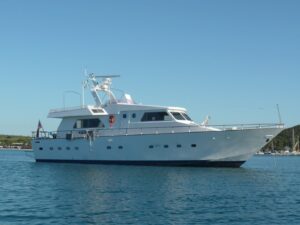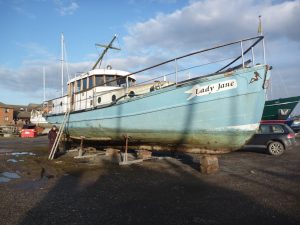HISTORY:
Originally named Senorita , but called many different names including Zarefah, Skipjack and Eniadae . She was built for A. H. Birtwistle and her sled number is only two numbers away from Tern . Apparently Birtwistle owned a fleet of Brixham trawlers.
There are a huge number of interesting things about her which are well documented in Claude Worth’s book – some are as follows:
– Claude describes in his book how he spent a long time designing his own brass work, fair leads, etc including pictures. These are the same on Senorita .
-The main roller furling gear he designed for Tern is exactly the same on Senorita . In her renovation, this has all been placed back according to original design.
-The floor straps for Tern were laminated iron made by the Wilkinson Sword Co – the same in Senorita . They have been drilled and forged from two different metals.
-The deck winch Claude Worth designed and commissioned by Pasley is also on Senorita.
-The dog house hatches on Senorita are the same as the ones on Tern .
– The line drawings in Claude Worth’s book are pretty much the same as those of Senorita .
-She was altered from a cutter rig to ketch in 1931. Evidence of this, as well as an aft cockpit installation by the type and quality of the work, it would likely have been carried out by Philips. The quality of work was identical to the original work carried out on the rest of the yacht. The introduction of a mizzen was, although extremely well-done, not a part of her original design.
-She was sailed to the USA in the 1970s and the owner has the contact information for the man who sailed her, which can be passed on to a new owner.
No doubt there are many more interesting facts to discover about the boat with a little further research.
BOW:
-The stem head roller was a large double roller, rarely seen on a yacht, but commonly seen on trawlers for veering lines. Sadly, the outer, large part of the roller was corroded and was no longer of any use. The inner, original part was re-used as the anchor roller as originally intended.
-The forward head of the stem was cut back and new oak laminate was put in place. The original knight’s head was completely rotted, so it was removed. The deck beams forward were all replaced as well as the beam shelf/clamp. The stem was re-bolted to the apron, and the bronze stem band removed and refastened. The hood ends were re-fastened and re-caulked and then covered with a copper strip to prevent any further water ingress.
-This part of the boat is now used for storage and anchor chain locker. The anchor originally came further aft, which would have been preferable since when the boat was built, this part of the boat had been crew accommodation. The fo’c’sle has a new bulkhead that separates it from the galley. Originally this whole area (bow & present galley) was crew accommodations. All deck beams in this area have been replaced and the new beam shelf continues.
-The original hatch was removed and replaced with new fastenings. The forward end is vented through this hatch and one of the original vents on a dorade box. The original lodging elbows were removed and replaced with all new fastenings. Although unnecessary, new lodging knees were fitted.
-Moving aft in the galley is an original bulkhead. On the opposite side is the main saloon which is constructed as she was originally designed, mainly of original materials which have all been removed and replaced.
-The new beam shelf continues aft. The beams in this area have been removed and repaired as necessary along with lodging and hanging knees. The mast partners were found to be completely rotted and with the original deck height being extremely low, the opportunity was taken to raise the deck house. Because the mast went through this deck house, it was very heavily constructed, the coamings of which are approximately 4.5 inches thick. New mast partners were made using oak and the original skylight was fitted on top of the new deck house. This new addition has provided much increased headroom and allowed for the provision of more port lights, bringing more light and ventilation down below.
-The panelling in the main saloon is easily removed to access the chain plate fastenings. The bolts from the chain plates have been removed. It should also be noted that the original iron chain plate bolsters were rotted. These were removed and replaced with new oak bolsters.
-Any framing repairs required were done using white oak. In addition, originally the chain plates were simply bolted through the frames. By straddled the frames with 2X8 timbers fastened to the frames, then re-bolted the chain plates through, thus spreading the load over a much wider area. Provision has been made for beaching legs, should they be required in the future.
-Aft of the main saloon, the next original bulkhead has been thickened and well-fastened to the hull to provide extra rigidity, rather than being merely a partition. The sole of the main companionway and supporting beams have been re-built. The heads and large shower were put in place in what had been the original galley. Here, the new beam shelf joins the original, which was found to be in serviceable condition.
AFT:
-This area which originally had the cockpit needed extensive repairs. All the deck beams had to be replaced completely to the end of the counter. Repairs had to be made to the horn timbers. The planking was refastened to this. All lodging and hanging knees were removed and replaced. Little was left of the original counter. This had to be rebuilt. The original was extraordinarily heavy using large sections of oak which had become saturated and placed a huge burden on the overhang. The re-constructed had to be equally strong but at least 50% lighter. Everything in this area is new and well-ventilated.
FRAMING AND GENERAL REPAIRS:
-All frames in the counter were replaced using oak, laminated with West System. These were bolted in place using 3/8 hot-dipped galvanized bolts.
-In the companionway and aft cabin, a weakness had been observed where the framing ran behind the stringer. For some reason, Philips had managed to stagger every futtock joint directly above the bilge stringer. In this area doubled frames of white oak help support this weakness – which may have been fine when the boat was new, but now needed a little help. These frames were all fastened with hot-dipped 3/8 bolts.
-The bilge stringer throughout the boat has been refastened with ½ inch hot-dipped galvanized bolts. In the main saloon, some repairs were done to the framing on the port side. Some were removed and replaced, but on the whole, the original oak framing appears to be very strong. On the starboard side, the framing was not rotted, but not as good as the port side. New intermediate laminate frame fitted between. These were laminated in one piece from the deck to the keel, and again fastened with hot-dipped galvanized 3/8 bolts. Other small repairs to the framing continued through to the bow.
-The bilge had originally been sealed with concrete to allow the bilge water to flow through to the stern. This has all been removed. The brass floor strap fastenings had completely deteriorated. All the floor straps were refastened where necessary with 5/8 hot-dipped galvanized bolts. They have been cleaned and painted and are all in serviceable condition.
-The wing bolts could not be removed without removing the ballast keel so they were randomly tightened to check their condition and seem to be fine. A keel bolt was drawn, probably the first one in this boat’s history and found to be in A1 condition. This and the wing bolts were made of a much superior bronze compared to the floor strap fastenings. The yacht has little in the way of a keelson and she derives much of her strength through her massive lead keel which runs for much of her length and is extremely wide in the center of the boat. The concrete was replaced and the original lead ballast in the bow was set back in the concrete.
PLANKING AND FASTENINGS:
-The huge garboard on the port side which is made of elm was removed, cut back and replaced. It was not deemed necessary to do this on the starboard side. Although she is 95% teak, a small section of elm planking was removed and replaced with best quality long-leaf pine.
-With the cost of new bronze, it was not feasible to do all necessary fastenings in bronze. In discussion with the shipyard, and due to the isolating properties of teak, we decided to use the galvanized fastenings as mentioned on all new work. Wherever refastening had to be done near existing yellow brass fastenings (hand wrought nails) silicone bronze 5X3/8 ring shank nails specially made here in the USA have been used, nearly 2000 fastenings in total. All the caulking was removed and re-caulked using oakum below the waterline and cotton above. The below water seams were all payed traditionally using a tar-based compound.
-The rudder post appears to have been replaced sometime in the more recent past and the original rudder refastened. The helm position has been removed, re-built and replaced along with the steering mechanism.
DECK:
-The entire deck has been replaced with two layers of ply €“ the underside layer being center-bead and edge gives the underside a traditional look. It has been coated with two layers of West System and cloth and painted seasonally as required. The cloth was taken up over the deck and an additional rubbing band was placed around the entire boat to protect the edge of the plywood.
-Originally, Senorita had traditional bulwarks with the stanchions piercing the deck through a covering board. The new bulwarks are lower than the original ones and more in-line with a cap rail. This is fastened through both the beam ends and the edge planking providing an extremely strong belting for the boat.
-All cleats and deck hardware have been re-bolted using new fastenings.
MAST AND RIGGING:
-The mast top has been replaced for 20′ with a long bird’s beak scarf. The standing rigging for the main mast, the forward 2 shrouds on both sides are original. The parcelling and serving were removed and found to be in excellent condition. They have been re-parcelled and served. The top mast, not refitted has all the original hardware available.
-The boom remains original with the aforementioned furling gear.
-All rigging blocks have been serviced.
-There are an assortment of sails. One is a new lightweight mainsail.
ENGINE:
– 70hp Leyland engine marinised by Westerbeke. The crankshaft has been ground. New bearing, pistons, liners and liner seals. The raw water pump has been completely rebuilt. Fully serviced and ready for operation. The cutlass bearing has been replaced. Batteries are all new. Tanks have been removed and cleaned. Fuel/water separator has been completely rebuilt. The engine has proved to be very reliable.
-The heat exchanger has been disassembled, cleaned. A new stainless steel water injector was made and all new hoses were fitted.
OWNERS COMMENTS:
This summer, my girlfriend and I took Senorita out for a sail after deciding to make a small square sail €“ since that is what she used to cross the Atlantic, I felt it would be easier for us to handle. I copied the design mentioned by Claude Worth and made a new lightweight cedar laminated yard. Despite being somewhat small, it managed to pull her along very well and was a delight to use. We have had had Senorita out in some reasonable swells both anchored and cruising and found she behaves very well. Not matter how much the seas toss her about, her seams remain dry. I do notice that beam-on, she will roll uncomfortably. This would be greatly helped with the replacement of the mizzen and a steadying sail.
I have a had a great love affair with this boat and while I will be very sorry to see her go, I would love to see the boat with someone who can start to look at the rig and get the most out of her sailing €“ which is what she was intended and designed for. I am not in the position to do this, and as I no longer live aboard, I feel it is time for her to move on. I would love to see her go back to the UK, or at the very least go to someone who has great knowledge of sailing her.
BROKERS NOTE:
An extremely rare opportunity to purchase a fine pedigree English yacht in the final stages of a complete re-fit by her knowledgable and capable shipwright owner. Unfortunately a change of plan now dictates the sale and Senorita is therefore offered at a very reasonable price for a quick sale. An ideal opportunity for those interested in classic yachts for extended cruising, living aboard or the Med. regattas. Once the rig is completed Senorita could easily be sailed back to the UK and as such would represent an excellent investment.
Contact us more more information, photographs or an appointment to view.
Guide Price : SOLD
Lying: New York
Viewing: Through the brokers

